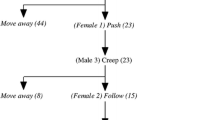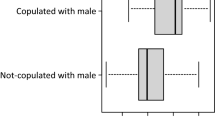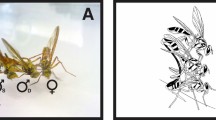Summary
Female preferences for dominant males in prairie and montane voles were analyzed in two different test situations. In the first, prairie vole females preferentially spent time in proximity to dominant versus subordinate males which were housed behind a wire mesh screen. In a two-male tether test prairie voles females both preferentially associated and mated with dominant males. Montane voles, on the other hand, showed no preference in either test situation. The baseline copulatory behavior of naive montane vole males which became dominant differed significantly from those which became subordinate; no such differences were evident in the baseline copulatory behavior of naive praire voles. One hour following dominance testing, there was no difference evident between dominant and subordinate males of either species but there was a general facilitation of male copulatory behavior in both species, the effect being of greater magnitude in montane voles.
Similar content being viewed by others
References
Allin JT, Banks EM (1968) Behavioral biology of the collared lemming Dicrostonyx groenlandicus (Triall): I. Agonistic behavior. Anim Behav 13:245–262
Arnold SJ (1983) Sexual selection: the interface of theory and empiricism. In: Bateson P (ed) Mate Choice. Cambridge University Press, Cambridge, pp 67–109
Benton D (1982) Is the concept of dominance useful in understanding behavior? Aggr Behav 8:104–107
Bernstein IS (1981) Dominance: The baby and the bathwater. Behav Br Sci 4:419–429
Buhl AE, Hasler JF, Tyler MC, Goldberg N, Banks EM (1978) The effects of social rank on reproductive indices in groups of male collared lemmings (Dicrostonyx groenlandicus). Biol Reprod 18:317–324
Carr WJ, Kimmel KR, Anthony SL, Schlocker DE (1982) Female rats prefer to mate with dominant rather than subordinate males. Bull Psychon Soc 20:89–91
Carter CS, and Getz LL (1985) Social and hormonal determinants of reproductive patterns in the prairie vole. In: Gilles R, Balthazart J (eds) Neurobiology. Springer, Berlin Heidelberg New York Tokyo, pp 18–36
Catanzaro D de, Ngan ET (1983) Dominance in intermale encounters and subsequent sexual success in mice. J Comp Psychol 97:269–278
Christian JJ, Davis DE (1964) Endocrines, behavior and population. Science 146:1550–1560
Costanzo DJ (1982) Copulatory patterns of socially dominant versus subordinate male rats. Presented at the 14th annual conference on reproductive behavior, East Lansing, Michigan
Costanzo DJ, Renfrew J (1977) Preferences of female rats for odors of dominant versus subordinate males. Paper presented at the meetings of the Psyconomic Society, Washington, D.C.
Dewsbury DA (1973) Copulatory behavior of montane voles (Microtus montanus). Behaviour 44:186–202
Dewsbury DA (1981) Social dominance, copulatory behavior, and differential reproduction in deer mice (Peromyscus maniculatus). J Comp Physiol Psychol 95:880–895
Dewsbury DA (1982) Dominance rank, copulatory behavior, and differential reproduction. Q Rev Biol 57:135–159
Dewsbury DA (1983) A comparative study of rodent social behavior in a seminatural enclosure. Aggr Behav 9:207–215
Emlen ST (1976) Lek organization and mating strategies in the bullfrog. Behav Ecol Sociobiol 1:317–335
Evans RL, Dewsbury DA (1978) Copulatory behavior of prairie voles (Microlus ochrogaster) in a two-male situation. Behav Biol 24:498–408
Fuentes S, Dewsbury DA (1984) Copulatory behavior in voles (Microtus montanus and M. ochrogaster) in multiple-female test situations. J Comp Physiol Psychol 98:45–53
Gavish L, Carter CS, Getz LL (1983) Male-female interactions in prairie voles. Anim Behav 31:511–517
Getz LL (1978) Speculation on social structure and population cycles of microtine rodents. Biologist 60:134–145
Getz LL, Carter CS (1980) Social organization in Microtus ochrogaster populations. Biologist 62:56–69
Getz LL, Carter CS, Gavish L (1981) The mating system of the prairie vole Microtus ochrogaster: Field and laboratory evidence for pair-bonding. Behav Ecol Socibiol 8:189–194
Gray GD, Dewsbury DA (1973) A quantitative description of copulatory behavior in prairie voles (Microtus ochrogaster). Brain Behav Evol 8:437–452
Halliday TR (1983) The study of mate choice. In: Bateson P (ed) Mate Choice. Cambridge University Press, Cambridge, pp 3–33
Hoffmeyer I (1982) Responses of female bank voles (Clethrionomys glareolus) to dominant vs subordinate males. Behav Neural Biol 36:178–188
Huck UW, Banks EM (1982) Differential attraction of females to dominant males: olfactory discrimination in the brown lemming (Lemmus trimucronatus). Behav Ecol Sociobiol 11:217–222
Huck UW, Banks EM, Wang S-C (1981) Olfactory discrimination of social status in the brown lemming. Behav Neural Biol 33:363–371
Jannett FJ (1977) On the sociobiology of the montane vole, Microtus montanus nanus (Rodentia: Muridae). Ph D Diss, Cornell University
Jannett FJ (1980) Social Dynamics of the montane voles Microtus montanus, as a paradigm. Biologist 62:3–19
Jannett FJ (1982) Nesting patterns of adult voles, Microtus montanus, in field populations. J Mammal 63:495–498
Jones RB, Nowell NW (1973) Aversive and aggression-promoting properties of urine from dominant and subordinate male mice. Anim Learn Behav 1:207–210
Kaufmann JH (1983) On the definitions and functions of dominance and territoriality. Biol Rev 58:1–20
Krames L, Carr WJ, Bergman B (1969) a pheromone associated with social dominance among male rats. Psychon Sci 16:11–14
Parmigiani S, Brunoni V, Pasquali A (1982) Behavioral influences of dominant, isolated and subordinate male mice on female socio-sexual preferences. Boll Zool 49:31–35
Pomerantz SM, Nunez AA, Bean NJ (1983) Female behavior is affected by male ultrasonic vocalization in house mice. Physiol Behav 31:91–96
Purvis K, Haynes NB (1972) The effect of female rat proximity on the reproductive system of male rats. Physiol Behav 9:401–407
Rood JP (1972) Ecological and behavioral comparisons of three genera of Argentine cavies. Anim Behav Monogr 5:3–82
Rowell TE (1974) The concept of social dominance. Behav Biol 11:131–154
Shapiro LE, Austin DJ, Ward SE, Dewsbury DA (1986) Familiarity and female mate choice in two species of voles (Microtus ochrogaster and M. montanus) Anim Behav 34 (in press)
Taylor GT, Regan D, Haller J (1983) Sexual experience, androgens and female choice of a mate in laboratory rats. J Endocrinol 96:43–52
Thomas JA, Birney EC (1979) Parental care and mating system of the prairie vole Microtus ochrogasten. Behav Ecol Sociobiol 5:181–186
Webster DG, Williams MH, Dewsbury DA (1982) Female regulation of choice in the copulatory behavior of montane voles (Microtus montanus) J Comp Physiol Psychol 96:661–667
White PJ, Fischer RB, Meuner GF (1984a) Discrimination of male social status by female hamsters. Psychol Rep 55:487–492
White PJ, Fischer RB, Meuner GF (1984b) The ability of females to predict male status via urinary odors. Horm Behav 18:491–494
Wilson EO (1975) Sociobiology: The new synthesis. Belknap Press, Cambridge, Mass
Author information
Authors and Affiliations
Rights and permissions
About this article
Cite this article
Shapiro, L.E., Dewsbury, D.A. Male dominance, female choice and male copulatory behavior in two species of voles (Microtus ochrogaster and Microtus montanus). Behav Ecol Sociobiol 18, 267–274 (1986). https://doi.org/10.1007/BF00300003
Received:
Accepted:
Issue Date:
DOI: https://doi.org/10.1007/BF00300003




